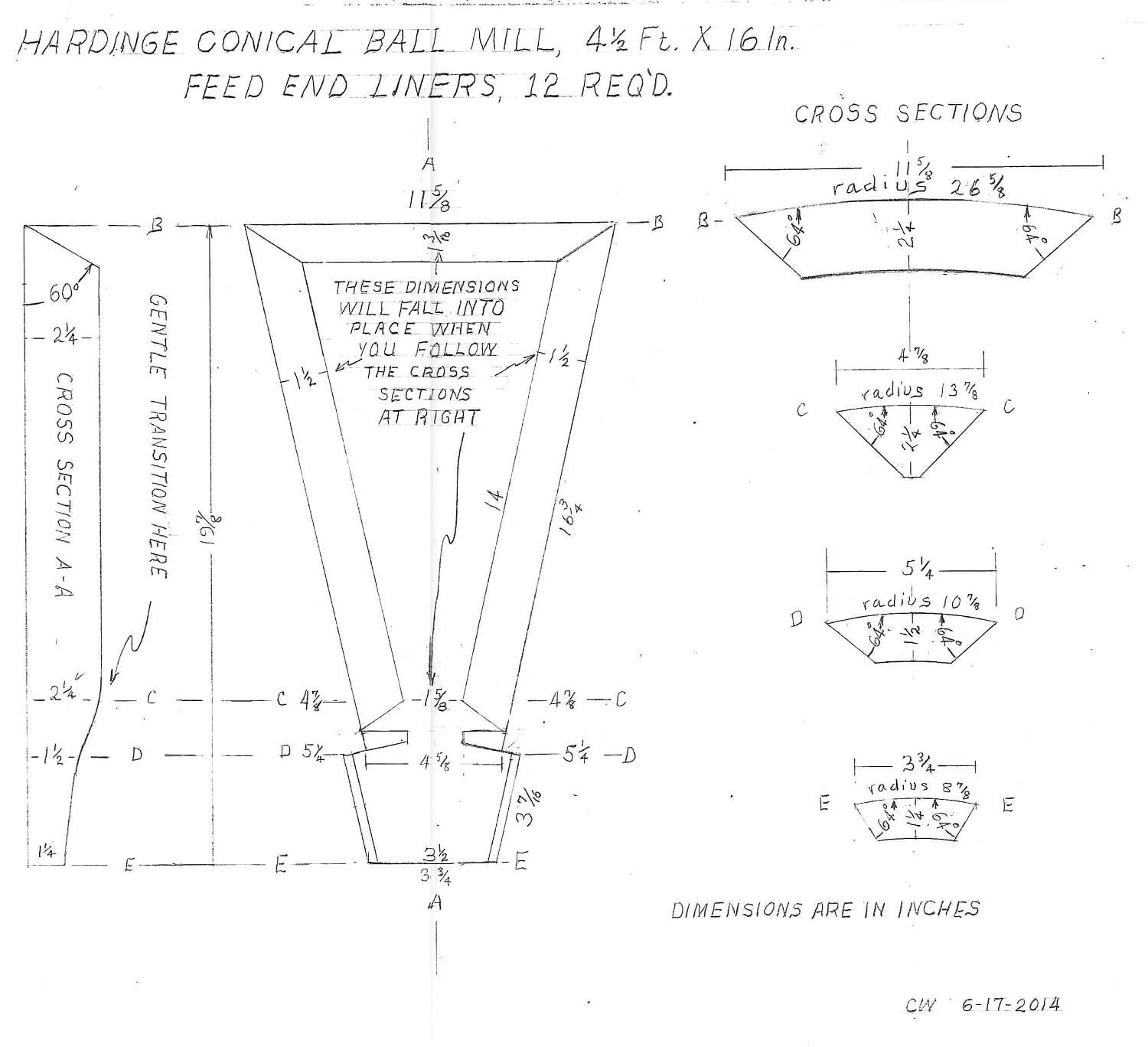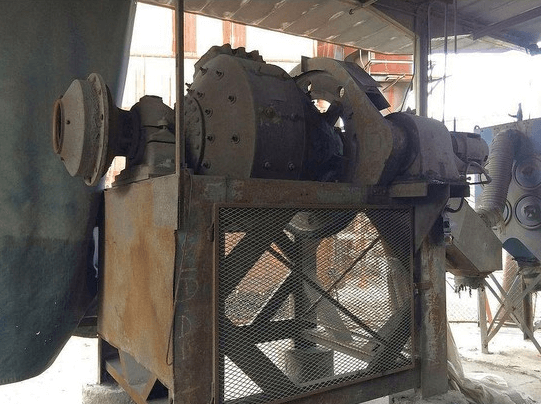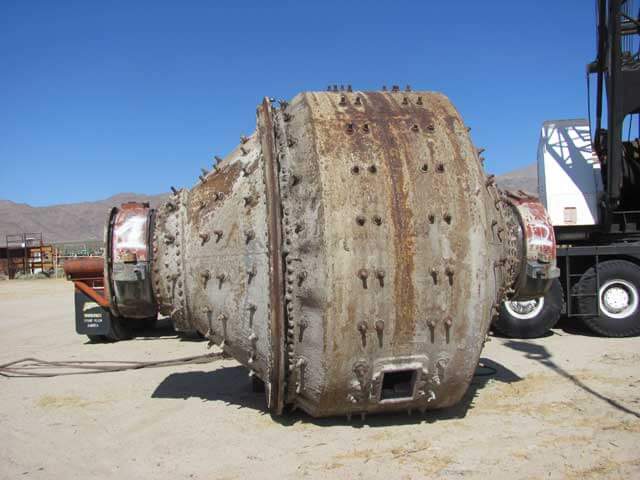 The Hardinge Ball Mill consists of three sections. After the usual type of trunnion bearing the mill consists of a short conical section showing a sharp drop from feed entrance to maximum mill radius. A cylindrical section of varying length then follows and toward the discharge end connects with a comparatively long and conical section sloping, at considerably less pitch than at the feed end, toward the discharge. In principle it has been claimed that a separation and grading of the balls in sizes, resulting in a corresponding graduation in the force of the crushing blow, occurred in the mill to the extent that single-passage crushing might be advocated. The successive reduction of the ore particle from rock to sand or gravel to slime was pictured as an actual achievement and as a logical departure from the normal current practice with cylindrical mills.
The Hardinge Ball Mill consists of three sections. After the usual type of trunnion bearing the mill consists of a short conical section showing a sharp drop from feed entrance to maximum mill radius. A cylindrical section of varying length then follows and toward the discharge end connects with a comparatively long and conical section sloping, at considerably less pitch than at the feed end, toward the discharge. In principle it has been claimed that a separation and grading of the balls in sizes, resulting in a corresponding graduation in the force of the crushing blow, occurred in the mill to the extent that single-passage crushing might be advocated. The successive reduction of the ore particle from rock to sand or gravel to slime was pictured as an actual achievement and as a logical departure from the normal current practice with cylindrical mills. 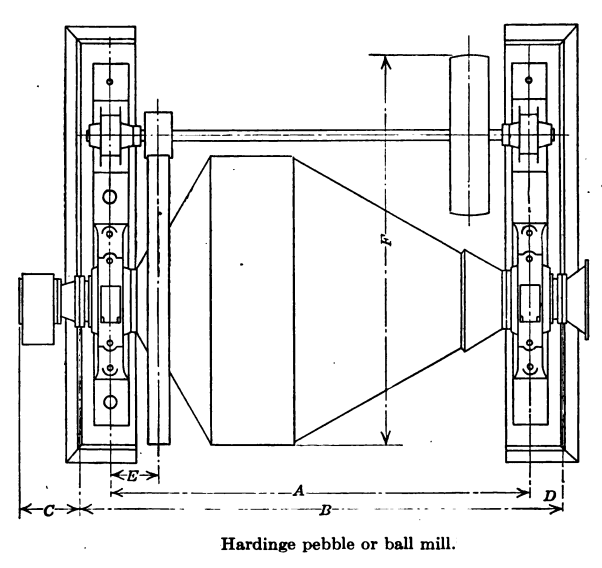 These views have been proved somewhat fallacious. The balls do not segregate to the extent assumed, and careful investigation has proved that the discharge sections may consist of balls of a larger average size than the medium of the balls used in the mill. A. F. Taggart (Trans. A. I. M. E., Sept., 1917) has also demonstrated that efficient Hardinge-mill operation cannot be effected by single-passage grinding, and a return classification system is indicated as desirable, as with the cylindrical mill. This would seem effectively to dispose of the ‘ graduated blow” theory.
These views have been proved somewhat fallacious. The balls do not segregate to the extent assumed, and careful investigation has proved that the discharge sections may consist of balls of a larger average size than the medium of the balls used in the mill. A. F. Taggart (Trans. A. I. M. E., Sept., 1917) has also demonstrated that efficient Hardinge-mill operation cannot be effected by single-passage grinding, and a return classification system is indicated as desirable, as with the cylindrical mill. This would seem effectively to dispose of the ‘ graduated blow” theory.
Standard Sizes of Hardinge Mills are given in Table XLVII. A summarized statement of data, consisting of the average performance of a number of these machines, is given in Table XLVIII.
Handbook of Ore Dressing: Equipment and Practice
The HARDINGE MILL is the invention of Mr. H. W. Hardinge, a Consulting Metallurgist of over thirty-five years’ experience in metallurgical work, who found it necessary to devise a machine which would be more efficient than the existing machines in use, such as rolls, cylindrical ball and tube mills, roller mills, hammer mills, and various types of high speed pulverizers. The Conical Mill is now being used in all parts of the World, having substituted these latter types of machines in the grinding of ores and other materials. Hardinge Conical Ball Mills are used to do the work of any combination of the above machines and will produce the desired results, depending upon the size and type of mill used.
Grinding can be done either wet or dry, and on account of the Conical shape of a Hardinge Mill, a positive discharge can be obtained without the use of internal screens, such as are employed with practically all high speed pulverizers and machines of the ordinary ball mill type.
CONICAL BALL MILL WORKING PRINCIPLE
It is a generally recognized fact that for economic reduction of any material, it is desirable to perform such reduction in steps or stages, removing that material which is sufficiently fine as soon as it is reduced and grinding it still finer in some device more adaptable to this finer reduction. It has been found that by so doing, the efficiency of the grinding machinery is increased, since material which is already finished and not removed interferes with the reduction of the coarser particles. This general principle is applied in the laboratory for the grinding of samples, where, after the material has been ground for a short time, it is screened for the purpose of removing the finished particles and the coarser material is then returned for further reduction.
Another application on a larger scale is the use of crushers or rolls in series with screens or trommels between them for removing finished or semi-finished material. It was with this idea in mind and with a realization that the machinery in use did not embody this principle, that the Conical Mill was devised.
In the Hardinge Mills, due to the action of the cones, the coarse material on entering the machine gravitates to the point of largest diameter. Here it comes in contact with, and is broken by, the largest balls moving at the highest velocity and falling from the greatest height. As the particles are broken, they automatically work their way forward, being subjected to a gradually diminishing breaking and crushing effect as they decrease in size. The particles undergoing reduction reach the required degree of fineness and arrive at the discharge end of the mill at the same time. Thus it is seen that this automatic classification, both of the material being reduced and of the grinding mediums, as well as their height of fall, proportions the energy expended or exerted in crushing to the work required to be performed. In this way, we obtain an ideal step or stage reduction in a single machine, which is conducive to a maximum crushing effect for a minimum expenditure of power.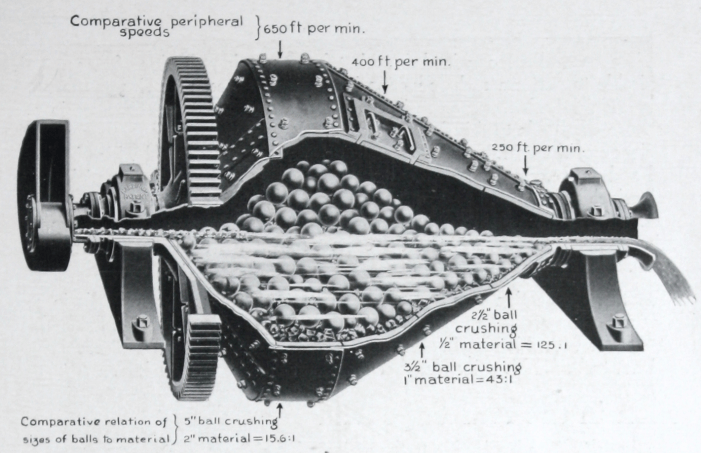
This classification of the material undergoing reduction, as well as of the grinding bodies, in which it is seen that in the largest diameter of the mill, the incoming feed is acted upon by the largest balls with the greatest superincumbent weight, the greatest height of fall, and the greatest peripheral speed. The grinding bodies and the crushing forces exerted are gradually reduced, as well as the size of the material undergoing reduction, as the discharge end is reached.
Source https://archive.org/details/TheHardingeConicalMillSectionVii
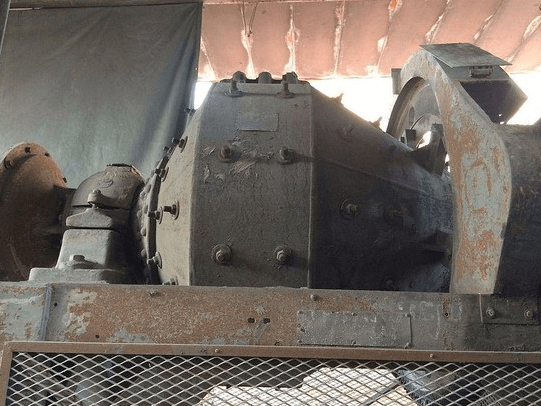
Hardinge Conical Ball Mill Liners
